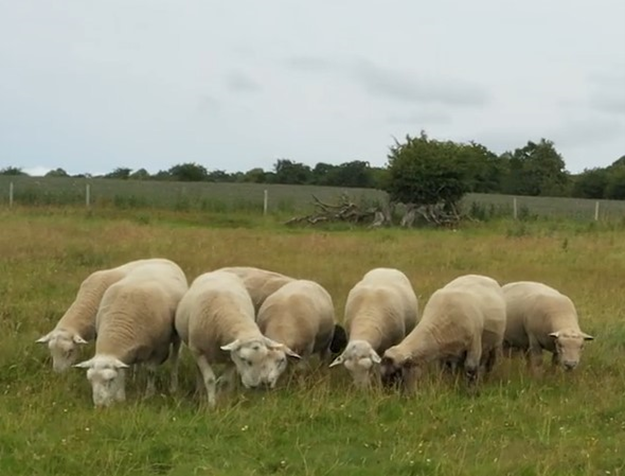Data Driven Decision Making: Flock Breeding Selection
15 November 2023Daniel Stout, SAC Sheep and Grassland Specialist alongside Duncan Nelless, farmer at Thistleyhaugh Farm, discuss using individual animal data to make more informed breeding decisions.
It is very important to have clear and concise breeding objectives to target data recording. Data collection is time consuming and requires investment. Too much data can be overwhelming (use a software programme), many traits are correlated, often negatively and selection for too many traits risks progress in few or no traits.
Key points
Remembering that output is only one part of the profit story one must consider:
- Traits that make you money: e.g. lamb growth rates, ewe milking ability, rearing rate and carcass traits.
- Traits that save you money: e.g. Lambing traits, FEC and stock that suit your system.
- Traits that save time: e.g. Lambing traits, dags and lameness.
- Traits that satisfy your customer: e.g. visual appearance- marketability (don’t get so lost in the figures that you lose this if selling store) and meat eating quality.
It is essential to have priorities right - increasing performance traits must always come secondary to systems suitability. For example, ease of lambing is essential if lambing outdoors to avoid excessive labour demand and lamb losses. Improving genetics is all about optimums, not extremes, we should be maintaining selection pressure and be strict in our culling policy.
It is also important to record parentage, for example in the case of a scanned ewe who turned out twins. It’s the only way to know answers to questions such as:
Did she rear both lambs? And did she rear them well to good weights? Was one well grown and the other poor? Was the best grown born a twin but reared a single? Are the best grown lambs simply born earlier? We can only know this by linking dam and offspring ID.
There are further benefits over the long term of having historical data on dam parentage. Historic data provides a wealth of information and more accurate data. Tagging at birth identifies lamb losses and true rearing success over the years and by having this recorded and plotted this allows you to identify top performers and weed out poorer genetics. See example below:

Thistleyhaugh Farm
Duncan Nelless is farming in a family partnership at Thistleyhaugh Farm on 860ha near Morpeth in Northumberland. They are rearing 2,000 Lleyn ewes plus 600 ewe lambs alongside 260 Angus based suckler cows with all surplus progeny finished and have 1,500 free range turkeys. They are part of the RamCompare project for terminal sire evaluation and are heavily recording data for this project as well as for their own business use.
Duncan has been recording data since 1996 and from 2008 has been recording birthweights, eight-week weights, scan weights and ultrasound scanning. He sees it as fundamental to the progress they have made as a business, and they actively use data for all their breeding decisions as well as to inform management decisions. They are also recording ewe weights and BCS four times per year at mating, scanning, eight-week weights and weaning.
The sheep flock is split into an A and B flock with the A flock consisting of ‘stud’ ewes bred as pure and the B mob ewes going to terminal rams which are selected in through the RamCompare project. All selection of ewes for the A and B mob are data driven using information from Signet EBVs and data analysed using FarmIT software. This data is integrated into their handling systems, and they have a three way auto drafter to support them when shedding stock into different groups.
Animals would be demoted to the B mob if there are visual, locomotion, teeth, or udder problems. Also, if they are in bottom 50% index, have poor balance of EBVs, low prolificacy, persistent assistance at lambing, high lamb mortality, low fat EBVs or major weight and BCS fluctuations.
For Duncan’s A flock ewe lambs’ selection, the ewe lambs must be bred as ewe lambs to meet his criteria. Ewe lambs will be culled if they required assistance at birth, had in-turned eye lids, have poor growth rates, or obvious construction problems e.g. feet structure or incomplete parentage.
For tup selection having clear and concise breeding objectives is key to success. Weight traits and maternal traits are important to the system but selecting for traits such as litter size and lamb survival have a low heritability value so it’s important when selecting traits to have an understanding of their interactions and heritability in order to see the fastest genetic progress.
Duncan and Daniel’s top traits for commercial flocks looking to use data for breeding selection:
- Weaning weight at 12-13 weeks – this gives a good reflection of both direct growth but also dam maternal and milking ability.
- Eight-week weight – an even better reflection of ewe maternal traits. Monitor DLWG of lambs, they should be +300g/day, do not retain lambs that have not been doing this.
- Record number of lambs scanned and reared - select ewes that repeatedly conceive and rear twins to select for both prolificacy and lamb survival.
- Ewe efficiency score - weight traits are highly correlated meaning selection for bigger lambs leads to increasing ewe mature weight and associated feed costs. So be careful here as while traits can make us money, they can lose us money.
“Make the data work don’t work for the data”.
Sign up to the FAS newsletter
Receive updates on news, events and publications from Scotland’s Farm Advisory Service

